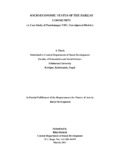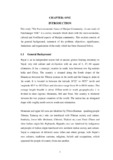Please use this identifier to cite or link to this item:
https://elibrary.tucl.edu.np/handle/123456789/3511| Title: | Socio-Economic Status of the Harijan Community (A Case Study of Panchanagar VDC, Nawalparasi District) |
| Authors: | Subedi, Rita |
| Keywords: | Socio economics;Community |
| Issue Date: | 2011 |
| Publisher: | Central Department of Rural Development |
| Institute Name: | Central Department of Rural Development |
| Level: | Masters |
| Abstract: | Nepal is an in independent nation full of ancient glories bearing testimony. It is a country of multilingual, multicultural, multi-religious and multi ethnic society i.e. it is composed of different castes, tribes and ethnic group having their own beliefs, customs and traditions among them Harijan are inhabit in western terrain belt of Nepal. They originally came from India and mostly found in Nawalparasi, Rupendehi, Siraha, Kapilbastu, Bara, Dhanusha, Saptari, Parsa, Sarlahi, Rautahat, Mahotari, Banke districts of Nepal. Their traditional occupation is skinning the dead animals and making shoes, and other kind of labor associated with farming. Harijan are those people who have been almost isolated and neglected by the government. Harijans are basically agriculture waged labour. The settlement of Harijan in Panchanagar, Nawalparasi district is in considerable number with comparison to that of the other districts. As seen by the study, the Harijan’s socio-economic condition in Panchanagar has been found as illiterate, oppressed and backwarded. They have been adopting different professions like agriculture labour, carpentry, cleaner, factory labour and vivid daily waged labour. From the ancient period they have developed their own customs, arts, morals, beliefs and socio-economic institutions. The present study entitled “Socio-economic Condition of Harijan Community: A Case Study of Panchanagar VDC” was conducted aiming to analyze the socio-economic condition and their livelihood aspects of Harijan of Panchanagar, Nawalparasi. To be specific, the objective of the study were to explore the economic condition of Harijan in the study area and to describe the socio-cultural practice of Harijan in order to trace out the factors of socio-cultural and economic changes of Harijan community. Both the primary and the secondary sources of data were used of the study. Primary data were collected through interview, key information survey and observation of the field while the secondary data were collected from VDC office, private agencies, government offices and various published and unpublished books and reports. Out of the total, only 26 households were selected following purposive sampling method and descriptive cum exploratory research design had been applied in the study. The Harijan started to observe Hindu festivals such as Dashain and Tihar giving more priority rather than their own festivals. The way of worshipping their village deities, believe in spirits, typical dress pattern, and cluster types of settlements distinctly differ from other ethnic groups. On the one hand due to the domination from high class castes and ‘Pahadiyas’ they are losing their native culture, philosophy of lifestyle, self-confidence about their own traditions, languages and on the other hand; due to the influence of hill people and other high castes people some significant changes have been seen in education, health sector, sanitations, economic activities and way of life style of Harijan community in Panchanagar VDC. Based upon the findings the paper suggests some recommendations to increase and to improve socio-economic condition of Harijan in Panchanagar. It mainly highlights for the low literacy rate of Harijan people so there should be special trend in incentive to the children of this tribe for education. They were not trained in any vocational guidance so proper training for mobilization of internal resources is required. |
| URI: | http://elibrary.tucl.edu.np/handle/123456789/3511 |
| Appears in Collections: | Rural Development |
Files in This Item:
| File | Description | Size | Format | |
|---|---|---|---|---|
| Cover.pdf | 45.1 kB | Adobe PDF |  View/Open | |
| Chapter.pdf | 481.72 kB | Adobe PDF |  View/Open |
Items in DSpace are protected by copyright, with all rights reserved, unless otherwise indicated.
